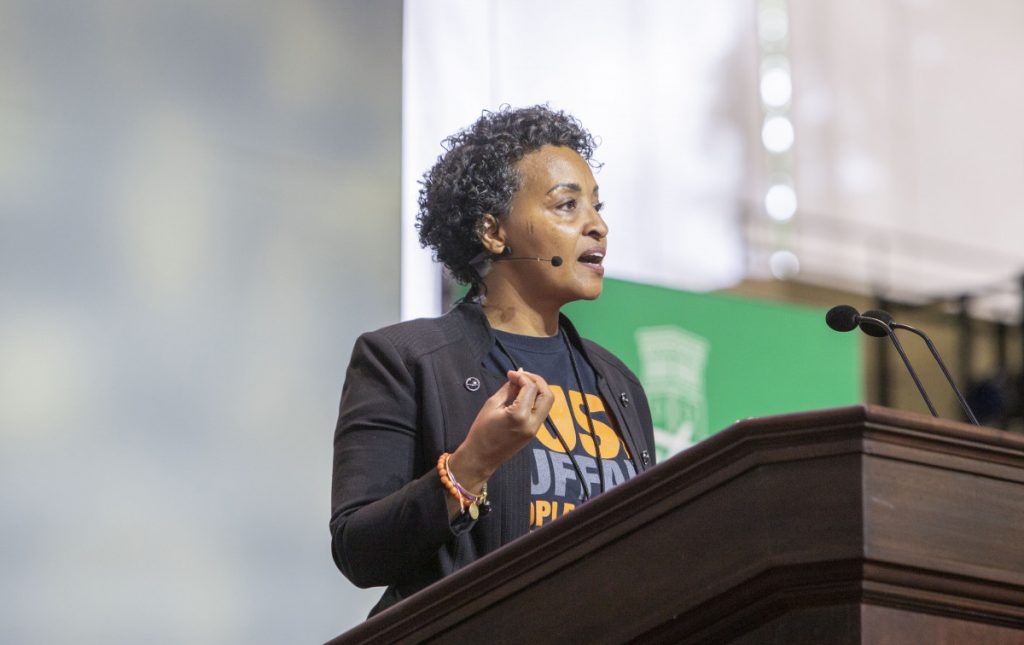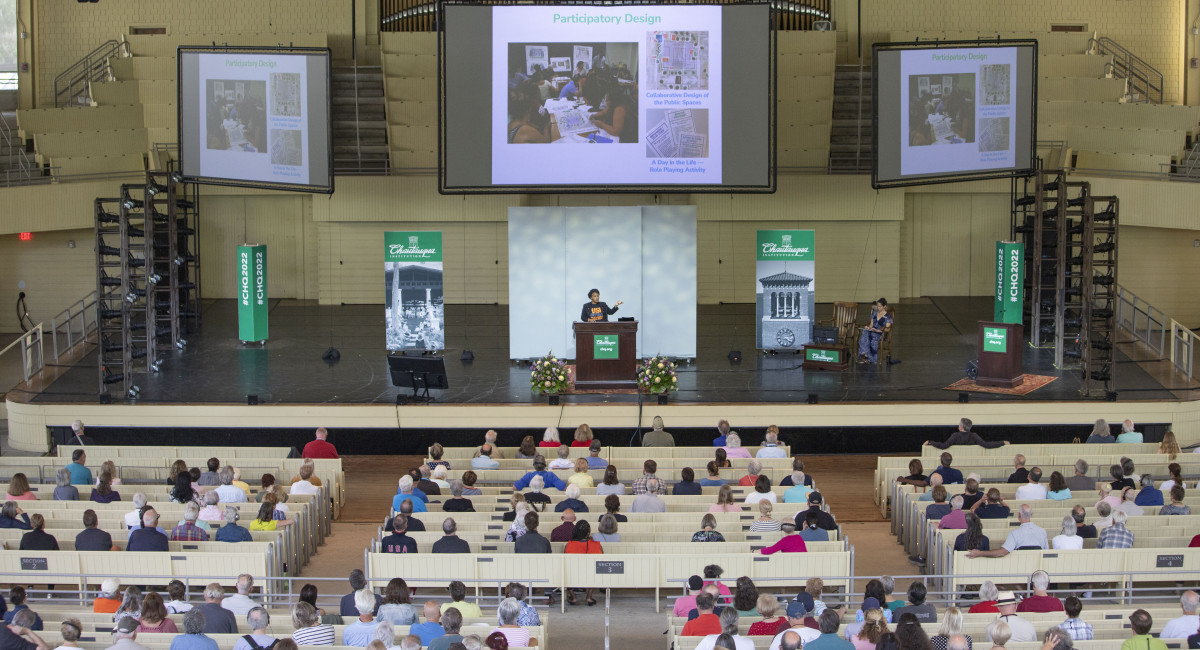Buffalo was once one of America’s prized cities. It had the sixth-largest economy among U.S. cities and a world-leading port. Today, it’s behind only Cleveland and Detroit as the United States’ poorest city.
A residual of the decisions that contributed to that downfall is historic and institutionalized disadvantage to its African American residents, according to Rahwa Ghirmatzion, the executive director of People United for Sustainable Housing — or PUSH — Buffalo, who spoke Wednesday, Aug. 10 in the Amphitheater for the Chautauqua Lecture Series.
Ghirmatzion is a trained community health worker and currently serves on the board of People’s Action Institute, a national multi-issue affiliate organization. She was born in Eritrea, a country in northeast Africa along the Red Sea, in the midst of a 30-year war for independence. At age 5, her family fled to Sudan following a dramatic 16-day journey. Her family emigrated three years later to Western New York.
Speaking under the umbrella of Week Seven’s theme, “More than Shelter: Redefining the American Home,” Ghirmatzion shared her experiences with PUSH Buffalo in combating housing injustices and reinvigorating Buffalo neighborhoods.
Ghirmatzion began by tracing Buffalo’s history. She shared a map of Buffalo in 1805, which she described as “a village rich with waterways and canals, innovation, and full of violence and destruction to Indigenous people and the environment.”
Following construction of the Erie Canal, Buffalo became the world’s largest freshwater port. Factory production drew immigrants and migrants from Europe and African Americans from the South. Ghirmatzion said it became an “industrial heartland” during the two world wars, and the birthplace of commercial aviation and innovations — including air conditioning.
“This is one of the best planned cities in America,” Ghirmatzion said, referring to early Buffalo.
Landscape architect Frederick Law Olmsted designed the city’s Delaware and Humboldt parks, linked together by tree-lined Humboldt Parkway.
“The city contains buildings designed by American architecture masters, like Frank Lloyd Wright, Louis Sullivan, Henry Hobson Richardson and Louise Blanchard Bethune,” she said, “making Buffalo one of the most architecturally significant cities in America.”
Buffalo’s subsequent decline, Ghirmatzion said, is partly a product of city planners’ and federal housing officials’ decision to facilitate urban flight.

She said that flight was propelled by the creation of the Federal Housing Administration, or FHA, and Home Owners’ Loan Corporation, or HLC, a government agency established in 1933 to stabilize real estate that had depreciated during the economic depression and to refinance urban mortgage debt. While HLC provided mortgages to rescue homeowners from bank foreclosures, the FHA offered insurance to guarantee that homeowners would repay their loans. That led to the practice of redlining, in which mortgages and insurance were denied to people living in neighborhoods considered high-risk for investment. Many of these neighborhoods were home to underrepresented minority populations.
“The FHA, the government agency, codified existing redlining housing discrimination regimes; discrimination that runs through all markets, labor and all services that still permeate today,” Ghirmatzion said, pointing to data that showed 81% of investment was in Buffalo’s suburbs. “It shows you this extractive economy that is already building where, again, it’s privileging some areas and disadvantaging others.”
The phenomenon was furthered in 1963, when the Kensington Expressway decimated the bucolic parks and parkway that linked Buffalo’s Black and white neighborhoods.
“What was called progress was just another moment of violence to Black Buffalo and the ecology,” Ghirmatzion said. The expressway “cut down the middle of what was at the time … a burgeoning Black middle-class community to make way for quick transportation of white people from the city to white suburbia.”
In the post-World War II era, Buffalo suffered a drastic decline, with the blame variously placed on failed leadership, natural resource depletion, environmental problems, and even oppressive taxes. Whatever the cause, the effect was deindustrialization and a loss of about half its population. By 1970, Buffalo’s population had dropped drastically from its former peak.
“Industry has left Buffalo with brown fields, waterways and the collapse of the working class,” she said. “This leads to a 50-year economic decline, taking Buffalo from the sixth-largest economy in the nation to the third-poorest city, only coming in behind Detroit and Cleveland.”
Enter PUSH Buffalo, founded in 2005. Ghirmatzion said PUSH Buffalo aims to address the root causes of the systemic oppression of Buffalo’s history — to create strong neighborhoods with affordable housing and local employment; and to advance racial economic and environmental justice.
PUSH Buffalo is not a city agency. In fact, its success is owed to mobilizing its members to advocate, even pressure, local officials, even as it works with grassroots groups around Western New York.
“Our theory of change revolves around community control, community ownership, and of resources and the just transition strategy framework for transformative structural change,” Ghirmatzion said.
Realizing the world’s – and Buffalo’s — immersion in an “extractive” economy that “digs, burns, and dumps,” Ghirmatzion said PUSH advocates for a “regenerative” alternative.
That green alternative exists “where the worldview is censored in caring and sacredness of our humanity, where resources are renewable energy sources and circular economies, where our work is actually cooperative and our purpose is restoring ecological harmony,” Ghirmatzion said.
On the west side of Buffalo, PUSH advocated for a 20-square-block green development zone, now expanded to 40 square blocks.
One of its highest-profile projects has been public school No. 77, circa 1927, which was eyeballed by developers for a condo complex, meaning imminent gentrification of the zone. PUSH Buffalo stalled the city’s approval for several years while it polled the community on how to use the building. Instead of high-end condos, there will instead be 30 affordable senior apartments.
“It’s the people that are of and from the community that not only designed it, planned for it, helped raise the money, co-designed the spaces, but now they are also the stakeholders that utilize it,” she said.
PUSH also works to restore vacant properties, using green construction methods such as sustainable roofs and solar panels. Other community features address the problem of stormwater runoff, with features such as parking pads that filter rainwater, rain gardens and vegetated stormwater planters.
PUSH Buffalo has spent $84 million in green affordable housing, green infrastructure and stormwater management in the green development zone. It owns about 150 parcels of land. More than a thousand homes have been weatherized, or subjected to a “green retrofit.” Ghirmatzion shared that in April 2022, PUSH Buffalo broke ground on 14 sites across its green development zone.
“We’re the small little seeds of decency that we can plant today and tomorrow, for the next generation or two,” Ghirmatzion said. “… We often say what the hands do, teaches the heart.”
Ghirmatzion closed by challenging the audience.
“What did you learn today to go back where you are, what’s a small little thing that you can do to continue to build on those cells of decency for collective impact that will lead to our collective liberation?” she said.





